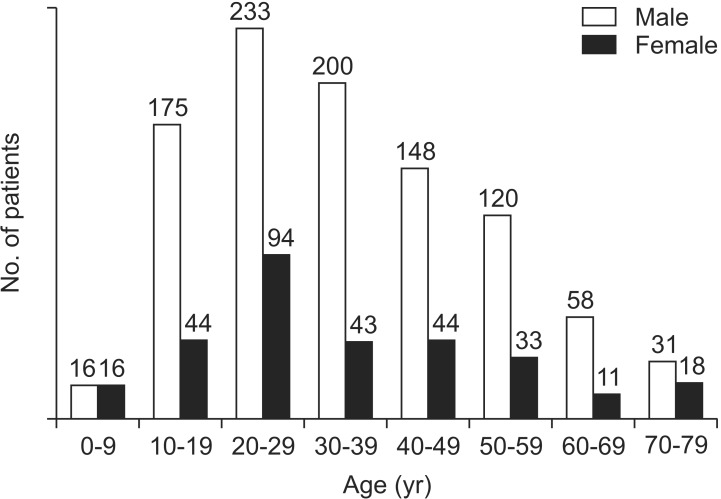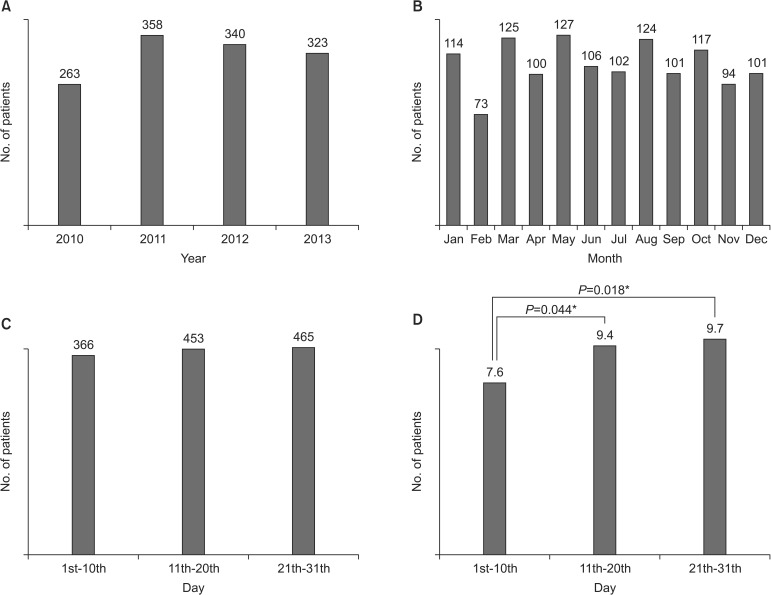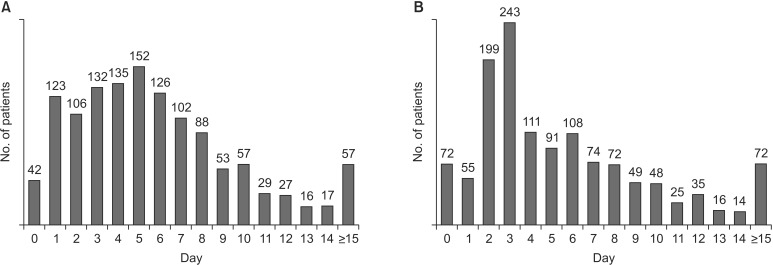J Korean Assoc Oral Maxillofac Surg.
2015 Dec;41(6):306-316. 10.5125/jkaoms.2015.41.6.306.
Fracture patterns in the maxillofacial region: a four-year retrospective study
- Affiliations
-
- 1Department of Oral and Maxillofacial Surgery, Section of Dentistry, SMG-SNU Boramae Medical Center, Seoul, Korea. neo0224@gmail.com
- 2Department of Oral and Maxillofacial Surgery, School of Dentistry, Seoul National University, Seoul, Korea.
- 3Department of Oral and Maxillofacial Surgery, School of Dentistry, Grand Dental Clinic, Seoul, Korea.
- KMID: 2133177
- DOI: http://doi.org/10.5125/jkaoms.2015.41.6.306
Abstract
OBJECTIVES
The facial bones are the most noticeable area in the human body, and facial injuries can cause significant functional, aesthetic, and psychological complications. Continuous study of the patterns of facial bone fractures and changes in trends is helpful in the prevention and treatment of maxillofacial fractures. The purpose of the current clinico-statistical study is to investigate the pattern of facial fractures over a 4-year period.
MATERIALS AND METHODS
A retrospective analysis of 1,824 fracture sites was carried out in 1,284 patients admitted to SMG-SNU Boramae Medical Center for facial bone fracture from January 2010 to December 2013. We evaluated the distributions of age/gender/season, fracture site, cause of injury, duration from injury to treatment, hospitalization period, and postoperative complications.
RESULTS
The ratio of men to women was 3.2:1. Most fractures occurred in individuals aged between teens to 40s and were most prevalent at the middle and end of the month. Fractures occurred in the nasal bone (65.0%), orbital wall (29.2%), maxillary wall (15.3%), zygomatic arch (13.2%), zygomaticomaxillary complex (9.8%), mandibular symphysis (6.5%), mandibular angle (5.9%), mandibular condyle (4.9%), and mandibular body (1.9%). The most common etiologies were fall (32.5%) and assault (26.0%). The average duration of injury to treatment was 6 days, and the average hospitalization period was 5 days. Eighteen postoperative complications were observed in 17 patients, mainly infection and malocclusion in the mandible.
CONCLUSION
This study reflects the tendency for trauma in the Seoul metropolitan region because it analyzes all facial fracture patients who visited our hospital regardless of the specific department. Distinctively, in this study, midfacial fractures had a much higher incidence than mandible fractures.
MeSH Terms
Figure
Reference
-
1. Miloro M, Ghali GE, Larsen PE, Waite P. Peterson's principles of oral and maxillofacial surgery. 3rd ed. Shelton: People's Medical Publishing House-USA;2012.2. Kim HG, Son YH, Chung IK. Facial bone fracture patients visiting Pusan national university hospital in Busan and Yangsan: trends and risks. Maxillofac Plast Reconstr Surg. 2014; 36:140–145.
Article3. Gassner R, Tuli T, Hächl O, Rudisch A, Ulmer H. Cranio-maxillofacial trauma: a 10 year review of 9,543 cases with 21,067 injuries. J Craniomaxillofac Surg. 2003; 31:51–61. PMID: 12553928.
Article4. Girotto JA, MacKenzie E, Fowler C, Redett R, Robertson B, Manson PN. Long-term physical impairment and functional outcomes after complex facial fractures. Plast Reconstr Surg. 2001; 108:312–327. PMID: 11496168.
Article5. Motamedi MH. An assessment of maxillofacial fractures: a 5-year study of 237 patients. J Oral Maxillofac Surg. 2003; 61:61–64. PMID: 12524610.
Article6. Down KE, Boot DA, Gorman DF. Maxillofacial and associated injuries in severely traumatized patients: implications of a regional survey. Int J Oral Maxillofac Surg. 1995; 24:409–412. PMID: 8636636.
Article7. Haug RH, Prather J, Indresano AT. An epidemiologic survey of facial fractures and concomitant injuries. J Oral Maxillofac Surg. 1990; 48:926–932. PMID: 2395044.
Article8. Morris C, Bebeau NP, Brockhoff H, Tandon R, Tiwana P. Mandibular fractures: an analysis of the epidemiology and patterns of injury in 4,143 fractures. J Oral Maxillofac Surg. 2015; 73:951.e1–951.e12. PMID: 25883009.
Article9. Greathouse ST, Adkinson JM, Garza R 3rd, Gilstrap J, Miller NF, Eid SM, et al. Impact of injury mechanisms on patterns and management of facial fractures. J Craniofac Surg. 2015; 26:1529–1533. PMID: 26114516.
Article10. Al Ahmed HE, Jaber MA, Abu Fanas SH, Karas M. The pattern of maxillofacial fractures in Sharjah, United Arab Emirates: a review of 230 cases. Oral Surg Oral Med Oral Pathol Oral Radiol Endod. 2004; 98:166–170. PMID: 15316543.11. Jeon EG, Jung DY, Lee JS, Seol GJ, Choi SY, Paeng JY, et al. Maxillofacial trauma trends at a tertiary care hospital: a retrospective study. Maxillofac Plast Reconstr Surg. 2014; 36:253–258.
Article12. Lee JH, Mun GH, Bang SI. A clinical & statistical analysis of the facial bone fractures: 7 years survey. J Korean Soc Plast Reconstr Surg. 1998; 25:1046–1052.13. Kwon HJ, Han J, Kim JH, Jung HY, Kim JY, Yoon SH, et al. Clinical epidemiologic study of facial bone fractures in Daegu. J Korean Soc Plast Reconstr Surg. 2007; 34:365–370.14. Schultz RC. One thousand consecutive cases of major facial injury. Rev Surg. 1970; 27:394–410. PMID: 5499146.15. Brook IM, Wood N. Aetiology and incidence of facial fractures in adults. Int J Oral Surg. 1983; 12:293–298. PMID: 6420354.
Article16. Brasileiro BF, Passeri LA. Epidemiological analysis of maxillofacial fractures in Brazil: a 5-year prospective study. Oral Surg Oral Med Oral Pathol Oral Radiol Endod. 2006; 102:28–34. PMID: 16831669.
Article17. Fonseca RJ, Marciani RD, Turvey TA, Carlson ER, Braun TW. Oral and maxillofacial surgery: trauma, surgical pathology, temporomandibular disorders. 2nd ed. St. Louis: Elsevier Saunders;2009.18. Iida S, Kogo M, Sugiura T, Mima T, Matsuya T. Retrospective analysis of 1502 patients with facial fractures. Int J Oral Maxillofac Surg. 2001; 30:286–290. PMID: 11518349.
Article19. James RB, Fredrickson C, Kent JN. Prospective study of mandibular fractures. J Oral Surg. 1981; 39:275–281. PMID: 6937624.20. van Beek GJ, Merkx CA. Changes in the pattern of fractures of the maxillofacial skeleton. Int J Oral Maxillofac Surg. 1999; 28:424–428. PMID: 10609743.
Article21. Ugboko VI, Odusanya SA, Fagade OO. Maxillofacial fractures in a semi-urban Nigerian teaching hospital. A review of 442 cases. Int J Oral Maxillofac Surg. 1998; 27:286–289. PMID: 9698176.22. Ellis E 3rd, el-Attar A, Moos KF. An analysis of 2,067 cases of zygomatico-orbital fracture. J Oral Maxillofac Surg. 1985; 43:417–428. PMID: 3858478.
Article23. Fonseca RJ, Walker RV. Oral and maxillofacial trauma. 3rd ed. St. Louis: Elsevier Saunders;2005.24. Kelly DE, Harrigan WF. A survey of facial fractures: Bellevue Hospital, 1948-1974. J Oral Surg. 1975; 33:146–149. PMID: 1054389.
- Full Text Links
- Actions
-
Cited
- CITED
-
- Close
- Share
- Similar articles
-
- Fracture patterns and causes in the craniofacial region: an 8-year review of 2076 patients
- Refracture at the same area after zygomaticomaxillary complex fracture surgery: a case report
- A retrospective study of mandibular fractures in children
- Etiology and patterns of mandibular fractures
- Retrospective Study on 527 Patients with Maxillofacial Trauma: A 5-year Experience






